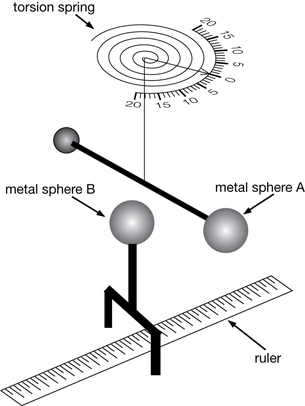Module 3
1. Module 3
1.12. Page 3
Module 3—Electrical Phenomena
Verifying Predictions about the Electrostatic Force
torsion balance: an instrument designed to measure small forces by the twisting of a thin wire
Although the thought processes used to answer the previous questions are very helpful as a starting point, it is important to verify these hypotheses with data collected from an experiment. Coulomb did this using a torsion balance. A detailed illustration of the torsion balance is shown in the following illustrations.

In Coulomb’s torsion balance, a horizontal, insulated rod is suspended by a thin, stiff fibre of silver wire. The wire twists when a force is exerted on sphere A, which is shown at the end of the rod. The force on sphere A causes the rod to rotate horizontally. The twisting of the wire can be measured at the suspension head at the top, which indicates the force acting on sphere A.
A simplified representation of this apparatus focuses on the suspension head at the top and the two charged spheres at the bottom. This simplified version shows how the variables of distance of separation (r) and charge (q) could be used to measure the electrostatic force

In this simplified scheme, the ruler can be used to measure the distance from the centre of sphere A to the centre of sphere B. If sphere A and sphere B were given like charges, a force would act on each sphere. This force would push the spheres apart. If sphere A were free to move, then it would be forced to rotate away from sphere B, causing the wire to twist. A larger force acting on sphere A would produce a greater twist in the wire, which could be indicated by the scale on the top.
Although Coulomb had no way of determining the exact amount of charge on an object, he did devise an ingenious method of varying the charge in a controlled way.
 Read
Read
To learn more about Coulomb’s method for varying charge, read page 528 in your textbook.
 Self-Check
Self-Check
You can check your understanding by answering this question:
SC 6. Coulomb used a third sphere, C, which was identical to sphere A and sphere B. Explain how Coulomb used sphere C to vary the charge on sphere B.
 Self-Check Answer
Self-Check Answer
SC 6. Sphere C was identical to sphere B, but it was neutral. If sphere C was touched by sphere B, then the charge on sphere B would be split evenly between spheres B and C. If sphere B began with an amount of charge that was ![]() , after being touched by sphere C, the charge on B would become half of the original value or
, after being touched by sphere C, the charge on B would become half of the original value or ![]() . This process could be repeated by first grounding sphere C before touching it to sphere B, which would remove half of the remaining charge on sphere B each time.
. This process could be repeated by first grounding sphere C before touching it to sphere B, which would remove half of the remaining charge on sphere B each time.
You will have an opportunity to collect data from a virtual torsion balance apparatus in the next investigation.